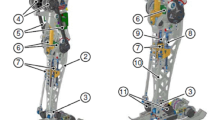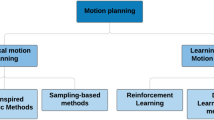Abstract
In evolutionary robotics, robot controllers are often evolved in simulation, as using the physical robot for fitness evaluation can take a prohibitively long time. Simulators provide a quick way to evaluate controller fitness. A simulator is tasked with providing appropriate sensor information to the controller. If the robot has an on-board camera, an entire virtual visual environment is needed to simulate the camera’s signal. In the past, these visual environments have been constructed by hand, requiring the use of hand-crafted models, textures and lighting, which is a tedious and time-consuming process. This paper proposes a deep neural network-based architecture for simulating visual environments. The neural networks are trained exclusively from images captured from the robot, creating a 3-dimensional visual environment without using hand-crafted models, textures or lighting. It does not rely on any external domain specific datasets, as all training data is captured in the physical environment. Robot controllers were evolved in simulation to discern between objects with different colours and shapes, and they successfully completed the same task in the real world.

















Similar content being viewed by others
Data availability
Training data and trained neural network models are available at: https://github.com/nate1021/Towards-Robot-Vision
Code availability
Full Code repository is available at: https://github.com/nate1021/Towards-Robot-Vision
Notes
Training computer—AMD Ryzen Threadripper; GeForce GTX 1080 Ti; 16GB RAM.
TensorFlow (tensorflow.org), PyTorch (pytorch.org).
References
Bongard JC (2013) Evolutionary robotics. Commun. ACM 56(8):74–83. https://doi.org/10.1145/2493883
Dupuis JF, Parizeau M (2006) Evolving a vision-based line-following robot controller. In: The 3rd Canadian conference on computer and robot vision (CRV’06). IEEE, pp 75–75
Engelbrecht A (2007) Computational intelligence: an introduction. Wiley, New York
Floreano D, Kato T, Marocco D, Sauser E (2004) Coevolution of active vision and feature selection. Biol Cybern 90(3):218–228
Floreano D, Suzuki M, Mattiussi C (2005) Active vision and receptive field development in evolutionary robots. Evol Comput 13(4):527–544
Gauci J, Stanley K (2007) Generating large-scale neural networks through discovering geometric regularities. In: Proceedings of the 9th annual conference on Genetic and evolutionary computation. ACM, pp 997–1004
Goodfellow I, Bengio Y, Courville A (2016) Deep learning. MIT Press. http://www.deeplearningbook.org
Greff K, Srivastava RK, Koutník J, Steunebrink BR, Schmidhuber J (2016) LSTM: a search space odyssey. IEEE Trans Neural Netw Learn Syst 28(10):2222–2232
Group K. OpenGL—The industry’s foundation for high performance graphics. https://www.opengl.org/. [Online; Accessed 18 Aug 2019]
Ha D, Schmidhuber J (2018) Recurrent world models facilitate policy evolution. In: Advances in neural information processing systems, pp 2450–2462
Harvey I, Husbands P, Cliff D (1994) Seeing the light: artificial evolution, real vision. School of Cognitive and Computing Sciences, University of Sussex Falmer
Hochreiter S, Schmidhuber J (1997) Long short-term memory. Neural Comput 9(8):1735–1780
Hornby GS, Takamura S, Hanagata O, Fujita M, Pollack J (2000) Evolution of controllers from a high-level simulator to a high dof robot. In: International conference on evolvable systems. Springer, pp 80–89
Jakobi N, Husbands P, Harvey I (1995) Noise and the reality gap: the use of simulation in evolutionary robotics. In: European conference on artificial life. Springer, pp 704–720
Kingma DP, Ba J (2014) Adam: a method for stochastic optimization. arXiv:1412.6980
Kingma DP, Welling M (2013) Auto-encoding variational bayes. arXiv:1312.6114
Koos S, Mouret JB, Doncieux S (2012) The transferability approach: crossing the reality gap in evolutionary robotics. IEEE Trans Evol Comput 17(1):122–145
Koutnik J, Gomez F, Schmidhuber J (2010) Evolving neural networks in compressed weight space. In: Proceedings of the 12th annual conference on Genetic and evolutionary computation. ACM, pp 619–626
Koutník J, Schmidhuber J, Gomez F (2014) Evolving deep unsupervised convolutional networks for vision-based reinforcement learning. In: Proceedings of the 2014 annual conference on genetic and evolutionary computation. ACM, pp 541–548
Koutnik J, Schmidhuber J, Gomez F (2014) Online evolution of deep convolutional network for vision-based reinforcement learning. In: International conference on simulation of adaptive behavior. Springer, pp 260–269
Lipson H, Bongard JC, Zykov V, Malone E (2006) Evolutionary robotics for legged machines: from simulation to physical reality. In: IAS, pp 11–18
Lund HH, Miglino O (1996) From simulated to real robots. In: Proceedings of IEEE international conference on evolutionary computation. IEEE, pp 362–365
Miglino O, Lund HH, Nolfi S (1995) Evolving mobile robots in simulated and real environments. Artif life 2(4):417–434
Narayan A (2018) Neuro-evolution and deep-learning for autonomous vision based road-following. Ph.D. Thesis, Aberystwyth University
Nolfi S, Floreano D (1998) Coevolving predator and prey robots: do “arms races” arise in artificial evolution? Artif life 4(4):311–335
Pratihar DK (2003) Evolutionary robotics—a review. Sadhana 28(6):999–1009
Pretorius CJ, du Plessis MC, Cilliers CB (2010) A neural network-based kinematic and light-perception simulator for simple robotic evolution. In: IEEE congress on evolutionary computation. IEEE, pp 1–8
Pretorius CJ, du Plessis MC, Cilliers CB (2013) Simulating robots without conventional physics: a neural network approach. J Intell Robot Syst 71(3–4):319–348
Pretorius CJ, du Plessis MC, Gonsalves JW (2014) A comparison of neural networks and physics models as motion simulators for simple robotic evolution. In: 2014 IEEE congress on evolutionary computation (CEC). IEEE, pp 2793–2800
Pretorius CJ, du Plessis MC, Gonsalves JW (2019) Evolutionary robotics applied to hexapod locomotion: a comparative study of simulation techniques. J Intell Robot Syst 96(3–4):363–385
Talathi SS, Vartak A (2015) Improving performance of recurrent neural network with relu nonlinearity. arXiv:1511.03771
Van Leeuwen M, Vreeken J, Koopman A (2003) Evolving vision-based navigation on wheeled robots. Institute for Information and Computing Sciences, Utrecht University
Watson RA, Ficici SG, Pollack JB (2002) Embodied evolution: distributing an evolutionary algorithm in a population of robots. Robot Auton Syst 39(1):1–18
Woodford GW, Du Plessis MC, Pretorius CJ (2015) Evolving snake robot controllers using artificial neural networks as an alternative to a physics-based simulator. In: 2015 IEEE symposium series on computational intelligence. IEEE, pp 267–274
Woodford GW, du Plessis MC (2018) Robotic snake simulation using ensembles of artificial neural networks in evolutionary robotics. In: Proceedings of the genetic and evolutionary computation conference. ACM, pp 173–180
Woodford GW, Pretorius CJ, du Plessis MC (2016) Concurrent controller and simulator neural network development for a differentially-steered robot in evolutionary robotics. Robot Auton Syst 76:80–92
Zagal JC, Ruiz-Del-Solar J (2007) Combining simulation and reality in evolutionary robotics. J Intell Robot Syst 50(1):19–39
Zaremba W, Sutskever I, Vinyals O (2014) Recurrent neural network regularization. arXiv:1409.2329
Zufferey JC, Floreano D, Van Leeuwen M, Merenda T (2002) Evolving vision-based flying robots. In: International workshop on biologically motivated computer vision. Springer, pp 592–600
Zufferey JC, Guanella A, Beyeler A, Floreano D (2006) Flying over the reality gap: from simulated to real indoor airships. Auton Robots 21(3):243–254
Acknowledgements
This work is based on research supported wholly by the National Research Foundation (NRF) of South Africa (Grant No. 117625). Opinions, findings and conclusions or recommendations expressed in this paper are those of the authors, not the NRF.
Author information
Authors and Affiliations
Contributions
NW—Wrote paper, wrote program, and ran experiments. MCdP—Supervised project, and edited paper.
Corresponding author
Ethics declarations
Conflict of interest
The authors declare that they have no conflict of interest.
Additional information
Publisher's Note
Springer Nature remains neutral with regard to jurisdictional claims in published maps and institutional affiliations.
Rights and permissions
About this article
Cite this article
Watt, N., du Plessis, M.C. Towards robot vision using deep neural networks in evolutionary robotics. Evol. Intel. 15, 81–97 (2022). https://doi.org/10.1007/s12065-020-00490-w
Received:
Revised:
Accepted:
Published:
Issue Date:
DOI: https://doi.org/10.1007/s12065-020-00490-w




